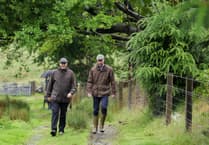A CONTROVERSIAL plan to build a whisky distillery on Dartmoor has hit an unexpected hurdle: a 1950s power station that was the first of its kind in the world, writes Stuart Fraser.
But experts say it should be possible to save industrial buildings at Princetown and still go ahead with the distillery.
The firm Princetown Distillers is behind the £4-million plan to set up production of 800,000 bottles a year of whisky, made in England’s largest and the UK’s highest plant.
But objections to the proposal for the site off Station Road outnumber letters of support by some four to one.
Now Dr Tom Greeves of the Dartmoor Society has written to the Dartmoor National Park Authority to say the application should be turned down unless two industrial buildings are preserved.
The Pocket Power Station, opened in 1959, is the first unmanned remotely-controlled power station in the world.
The station was switched on remotely on December 11, 1959 by the Lord Mayor of Bristol and was visited by Richard Wood, Minister of Power, on June 30, 1960.
The earlier, 1923, electricity generating station, known as the ‘Pressed Men Building’, is also of importance, said Dr Greeves.
‘The whole story of energy generation is such a current issue,’ he said. ‘If you can leave some tangible evidence of it that enriches all of us.
‘It’s important for us to keep cultural diversity in the landscape, just as it is to keep bio-diversity in the environment.’
In documents before the planning committee, DNPA building conservation officer Nigel Pratt writes: ‘Given the size of the development site, it would seem possible to incorporate this (1959) building and avoid its demolition.
‘This structure represents the remains of the world’s first jet-powered electricity generation station.
‘It was unmanned and remotely controlled from Bristol and represented cutting edge technology when built in 1959.’
He said a plaque on the building showing the Viking god Thor carrying a thunderbolt should be preserved, even if the building is demolished.
In a report, archaeologist Lee Bray recommends preserving both buildings.
He writes: ‘(The Pocket Power Station’s) historical value is considerable, not only locally, but at an international level.
‘The significance of both buildings, especially that derived from their historical value, is such that both should be considered undesignated heritage assets.’
Both men say a full survey is needed of the buildings as it is not known what remains inside – though the machinery from the power station is now housed in a museum in Wales.
But Mr Pratt admits the buildings have ‘limited aesthetic value’ and Mr Bray writes of the ‘unprepossessing, steel-clad appearance’ of the power station and ‘limited aesthetic value’. The site has been inspected by Historic England and turned down for listing.
Greg Millar of Dartmoor Whisky Distillery said: ‘I don’t think it appropriate for us to comment at this stage.’
The application is due to be decided upon by DNPA planners in March.
A contemporary Pathé news film about the plant can be seen at: www.britishpathe.com/video/proteus-turbo-generator-for-worlds-first-unmanned


-is-praised-for-her-imaginative-shop-wind.jpeg?width=209&height=140&crop=209:145,smart&quality=75)


Comments
This article has no comments yet. Be the first to leave a comment.